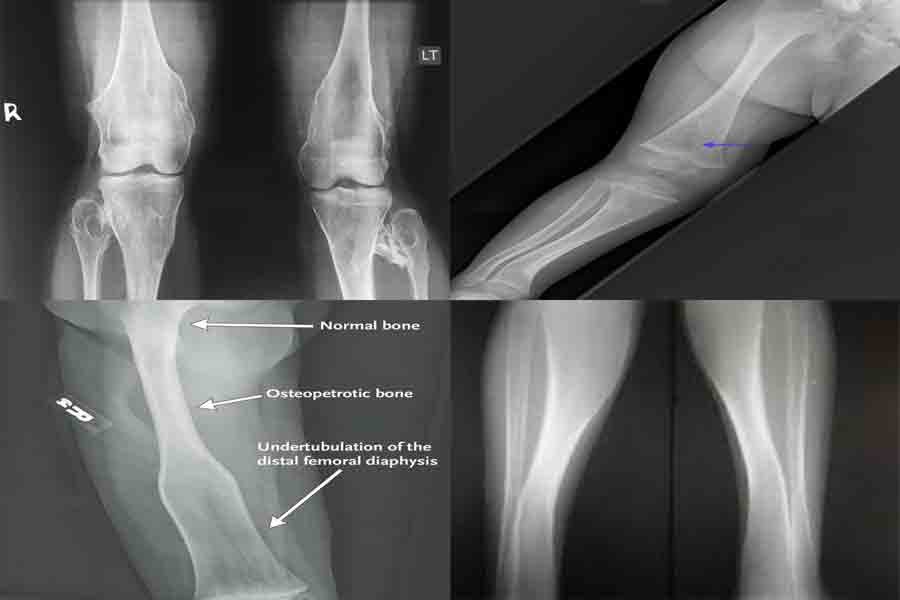Erlenmeyer Flask Deformity
Table of Contents
Introduction
In the annals of scientific exploration, anomalies often serve as gateways to new discoveries and insights. One such anomaly that has captivated researchers for decades is the curious phenomenon known as Erlenmeyer flask deformity.
Named after the iconic laboratory vessel, this peculiar skeletal abnormality presents itself as a distinctive conical shape in the long bones of the body.
Erlenmeyer flask is the invention of Emil Erlenmeyer
In this comprehensive exploration, we embark on a journey to uncover the origins, manifestations, and far-reaching implications of Erlenmeyer flask deformity, delving deep into the realms of medicine, anthropology, and genetics.
list of conditions and causes associated with Erlenmeyer flask deformity:

1. Osteopetrosis: a group of rare inherited bone disorders characterized by increased bone density and abnormal bone growth. Erlenmeyer flask rupture is often seen in people with osteopetrosis.
2. Goucher disease: It is an inherited metabolic disorder in which fatty substances accumulate in cells and certain organs. Individuals with Gaucher disease may have skeletal abnormalities, including Erlenmeyer flask deformity.
3. Thalassemia: Thalassemia is a group of inherited blood disorders characterized by abnormal hemoglobin production. In severe cases, thalassemia can cause bone abnormalities, including Erlenmeyer flask deformity.
4. Hypophosphatasia: It is a rare inherited metabolic disorder characterized by poor mineralization of bones and teeth. Erlenmeyer flask deformity may be a skeletal manifestation of hypophosphatasia.
5. Sickle Cell Disease: This is a group of inherited red blood cell disorders in which red blood cells become hard and sticky, causing blockage of blood vessels. People with sickle cell disease may have chronic bone problems, including Erlenmeyer flask malformation.
6. Chronic Lead Poisoning: Chronic exposure to lead, often through contaminated water or lead-based paint, can cause lead poisoning. Chronic lead poisoning can affect bone development and cause bone abnormalities such as Erlenmeyer flask deformity.
7. Metaphyseal Dysplasia: This is a group of rare genetic disorders affecting the metaphysis, which is the part of a long bone near the growth plate. Some types of metaphyseal dysplasia can cause Erlenmeyer flask deformities.
8. Other Genetic and Metabolic Disorders: Other rare genetic and metabolic disorders can cause Erlenmeyer flask defects as a result of abnormal bone growth and development.
Unveiling the Anomaly:
At the heart of the Erlenmeyer flask deformity lies a striking morphological anomaly observed in the long bones, particularly the femurs and humeri.
“Unlike the usual cylindrical structure of healthy bones, individuals with this deformity exhibit a significantly widened and flattened metaphyseal region, resembling the conical shape of an Erlenmeyer flask.”
This distinctive shape, often likened to a “club,” “bottle,” or “flask,” sets it apart as a unique anomaly in skeletal biology.
Initially noted in individuals with certain genetic disorders, such as osteopetrosis and various dysplasias, the deformity has since emerged as a subject of keen interest across multiple scientific disciplines.
Exploring the Origins:
To unravel the origins of Erlenmeyer flask deformity, one must navigate a complex interplay of genetic, environmental, and developmental factors.
While it is primarily associated with genetic conditions affecting bone metabolism and remodeling, such as osteopetrosis, several environmental influences have also been implicated in its manifestation.
Nutritional deficiencies, exposure to toxins, metabolic disorders, and even mechanical stress during bone development are among the myriad factors that may contribute to the development of this intriguing anomaly.
Understanding the intricate web of interactions between genetics and the environment is essential for elucidating the underlying mechanisms driving its formation.
Medical and Anthropological Implications:
The significance of Erlenmeyer flask deformity extends far beyond its mere morphological peculiarity. From a medical standpoint, its presence often serves as a crucial diagnostic marker for underlying genetic disorders and metabolic abnormalities affecting bone health. Clinicians rely on its distinctive appearance to guide diagnostic evaluations and formulate appropriate treatment strategies for affected individuals.
Furthermore, its prevalence and distribution among different populations offer valuable insights into human migration patterns, evolutionary history, and adaptation to diverse environmental challenges.
By studying the distribution of this deformity across geographically and genetically distinct populations, anthropologists can unravel the intricate tapestry of human ancestry and migration, shedding light on the adaptive strategies employed by our ancestors to thrive in varying ecological niches.
Challenges and future directions:
Despite decades of research, numerous questions surrounding Erlenmeyer flask deformity remain unanswered, presenting formidable challenges for scientists and clinicians alike.
Elucidating the precise genetic and environmental factors contributing to its development, as well as its full spectrum of clinical implications, represents a paramount priority for future research endeavors.
The riddles surrounding this puzzling aberration may be solved through advances in imaging technology, genomic analysis, and interdisciplinary collaborations.
This would open the door to better therapeutic approaches, diagnostic techniques, and a greater comprehension of the biology of the human skeleton.
Conclusion:
In conclusion, Erlenmeyer’s deformity stands as a testament to the intricate complexities of human biology and evolution.
Its distinctive appearance in skeletal structures serves as a poignant reminder of the myriad forces shaping our genetic heritage and morphological diversity.
As researchers continue to unravel its mysteries, the study of Erlenmeyer flask deformity promises to yield invaluable insights into our shared biological heritage, offering a glimpse into the remarkable adaptability of the human body across space and time.
Through collaborative efforts spanning disciplines and generations, we endeavor to illuminate the path toward a deeper understanding of this captivating anomaly and its implications for human health and evolution.

